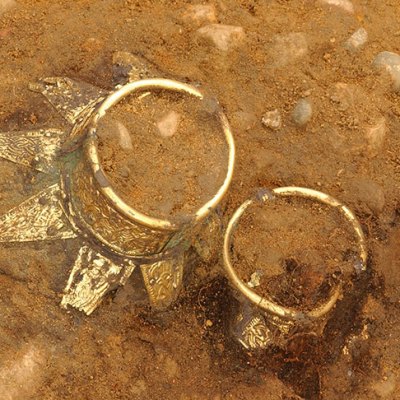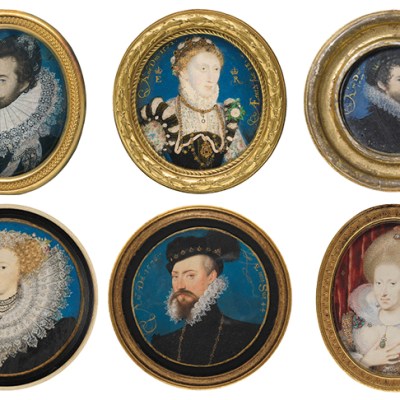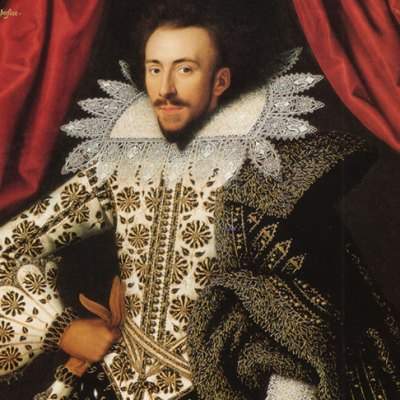It is October 2019, but it could almost be 1519. We are standing in the Long Gallery at Hever Castle in Kent, surrounded by the portraits of the lead players in the Wars of the Roses and the founders of the Tudor dynasty: Henry VII, who defeated Richard III at the Battle of Bosworth; Henry’s mother-in-law Elizabeth Woodville; and his mother, the poker-faced Margaret Beaufort. The portraits are displayed as they would have been in the 16th century, with a pair of curtains over each one. These curtains were decorative but also practical, protecting the pictures from light damage and soot from candles and fires, and heightening the dramatic effect of the viewing for visitors when the picture was finally revealed.
But it is not 1519, and we are here for a different unveiling: on the 567th anniversary of Richard III’s birth, Hever Castle announced the acquisition of his portrait, the newest addition to their fine collection of Tudor paintings. This portrait, dating from the late 16th century, presents the classic image of the ‘Marmite’ king: with his knave-of-cards haircut, richly jewelled and furred, he gazes into the middle distance, playing with the ring from his little finger. His reputation now somewhat rehabilitated, for the Tudors who had taken his throne Richard III was the arch-villain, a context to which Hever’s guest curator, the Tudor expert David Starkey, wants to return him.
Like most portraits of Richard III, the Hever version descends from the portrait in the Royal Collection. This was painted in c. 1500–20, several decades after Richard’s death, but was probably based on a now-lost original made during his reign. X-rays reveal that the Royal Collection version was altered, perhaps shortly after it was made, to accentuate the unevenness of Richard’s shoulders, better to represent the Tudor image of him as, in Shakespeare’s words, a ‘bunch-back’d toad’. Interestingly, however, a rather different early portrait of him in the collection of the Society of Antiquaries in London (c. 1510–40) also seems to show him with uneven shoulders, an image seemingly corroborated by the purported discovery of his skeleton in 2012, which was found to have scoliosis, or curvature of the spine.
Richard III (late 16th century), English School. © Hever Castle & Gardens

Along with uneven shoulders, another inheritance from these earlier images is the motif of Richard playing with his ring. In the now-lost original this probably related to betrothal or marriage: it was common for portraits to be exchanged during marriage negotiations, and a painting may have been commissioned in 1485, when Richard was widowed and searching for a new wife. However, the repetition of this motif in later portraits suggests that it may have become associated with the king’s reputation for being neurotic and fidgety, along the lines of Polydore Vergil’s less-than-objective Anglica Historia, an account written for Henry VII in the early 16th century:
[Richard III] was little of stature, deformed of body, the one shoulder being higher than the other, a short and sour countenance, which seemed to savour of mischief, and utter evidently craft and deceit. The while he was thinking of any matter, he did continually bite his nether lip, as though that cruel nature of his did so rage against it self in that little carcass. Also he was wont to be ever with his right hand pulling out of the sheath to the midst, and putting in again, the dagger which he did always wear.
Most of the surviving images of Richard III were made during the 16th century, for settings exactly like that at Hever: a ‘long gallery’ replete with images of kings and queens, heroes and villains of distant and recent history. But why would 16th-century nobility want a picture of Richard III, an enemy of the Tudor state? The answer lies in the broader purposes of the long gallery in the grand houses of Elizabethan England.
The long gallery at Hever Castle

As well as a place to walk and entertain guests, the long gallery was a site for self-promotion and education. Portraits of rulers, English and foreign, taught viewers about past and current history, and told of a family’s loyalty to the crown. Above all, portraits were used as moral exemplars, illustrating virtues and vices, and encouraging viewers to emulate the good and avoid the bad. As the Tudor writer Lawrence Humphrey put it in The Nobles, or Of Nobility (1563), portraits were displayed so that ‘children might gaze on the images and titles of their ancestors: and not only read their virtues, but learn to counterfeit them’.
However unfair we may think it now, for the Tudors who defeated him Richard was firmly in the category of bad exemplars, his defeat at Bosworth the ultimate moral judgment on his reign. His presence in a long gallery of the 16th century – such as the one recreated at Hever Castle – would have been seen as a terrible warning of the dangers of hubris and the pursuit of power at any cost: a lesson which might even benefit politicians today.
Christina J. Faraday is an affiliated lecturer in the History of Art Department at the University of Cambridge and an AHRC/BBC New Generation Thinker 2019. She specialises in the art and architecture of Tudor and Jacobean England.


